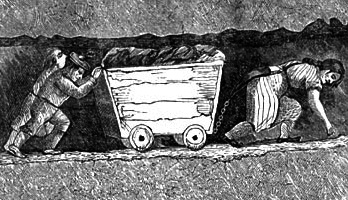
A hurrier, also sometimes called a coal drawer or coal thruster, was a child or woman employed by a collier to transport the coal that they had mined. Women would normally get the children to help them because of the difficulty of carrying the coal. Common particularly in the early 19th century, the hurrier pulled a corf (basket or small wagon) full of coal along roadways as small as 0.4 metres (16 in) in height. They would often work 12-hour shifts, making several runs down to the coal face and back to the surface again.[1][2]
Some children came from the workhouses and were apprenticed to the colliers. Adults could not easily do the job because of the size of the roadways, which were limited on the grounds of cost and structural integrity.[2] Hurriers were equipped with a "gurl" belt – a leather belt with a swivel chain linked to the corf. They were also given candles as it was too expensive to light the whole mine.[2]
- ^ Channel 4. "The Worst Jobs in History - Hurrier". Accessed from the Wayback Machine on 13 November 2009.
- ^ a b c HalifaxToday.co.uk. "The Nature Of Work Archived 2006-10-07 at the Wayback Machine". Accessed 17 February 2007.